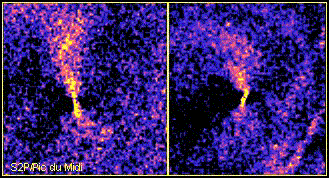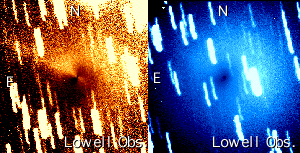EJECTED DUST IS BIGGER THAN 30 MICRON
The dust ejected by comet 55P/Tempel-Tuttle was of relatively large size, reported David K. Lynch, Ray W. Russell and Michael Sitko at the Leonid Meteoroid Storm and Satellite Threat Conference in Manhattan Beach (April 27-28, 1998). They measured the mid-Infrared spectra of the cometary dust using the Broadband Array Spectrograph System on the NASA 3-meter Infrared Telescope Facility (IRTF). They found a smooth infrared spectrum between 3 and 13.5 micron, with no sign of the Si-O stretch vibration band at 10 micron. The authors concluded that the grains had to be bigger than 30 micron to not show such feature at the time of the observations on February 8 and 9, 1998.

A JET AND A ROTATION PERIOD
These images of 55P/Tempel-Tuttle show a dust jet. The images were obtained after a radial profile substraction and a rotational gradient and are part of a research effort at the Pic du Midi Observatory in France by a team of observers, including L. Jorda (Max Planck Institute for Aeronomie), J. Lecacheux (Meudon Observatory), F. Colas (Bureau des Longitudes, Paris), E. Frappa (Planetarium de Saint-Etienne, France) and P. Laques (Bagneres-de-Bigorre, France). The reduction of many observation nights allowed the observers to find two possible spin periods for the comet. This information was published in the IAU Circular 6816 on 1998, January 30th. In their posting of February 2nd, Jean Lecacheux, Eric Frappa and Francois Colas report that the rotation period of the nucleus is: 15.33 +/- 0.02 hours.

DUST TAIL SEEN
Tony Farnham of Lowell Observatory posted the preliminary results of his research of comet 55P/Tempel-Tuttle , presenting evidence of a dust tail in the near-infrared R-band images that is not seen in visual V-band images. An 1/rho profile was subtracted off the original images to enhance features in the inner coma. Tony reported: "Comparison of images obtained with the R and V filters that were taken one shortly after the other (Left and right, respectively, displayed in false colors), shows a very different appearance. The R image primarily shows the dust emitted from the comet, while the V image is primarily gas and ions. Note that the R frame shows a narrow tail extending to the left and slightly upward, that does not appear in the more diffuse morphology of the V image. This is apparently a dust tail composed of very small particles that are being pushed away from the sun."
These particles are lost from the cloud of larger grains that may once cause Leonid meteors on Earth.